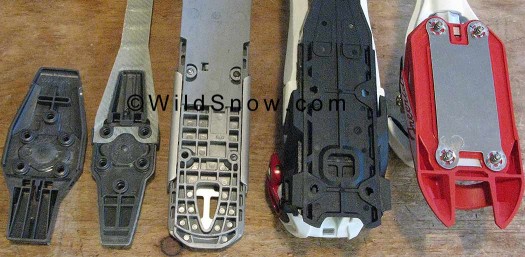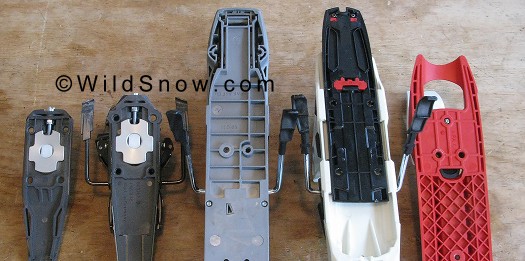I don’t know exactly how many of you have actually ripped a properly mounted AT binding out of a ski, but I do know that exalted badge of honor is reserved for a vast minority of backcountry skiers. Such a minority, in fact, that I can’t remember it ever happening to anyone I know, nor EVER having to deal with it in our shop.
Nonetheless, binding ripping happens, and when it does you can be sure someone will write about it on the web (sometimes with obvious relish for the attention their blog or forum post will garner). Following that, many of you will begin obsessing on ripping bindings and wonder if 1, if your bindings are going to rip out of YOUR skis. And 2, if somehow you could get a binding that would be more resistant to ripping out of our skis, even though you have never had a binding rip out of skis.
A subset of all that is that to prevent the possibility of backcountry skiing bindings ripping out of skis, many of you want bindings with a wider screw pattern or base plate platform — especially wider than Dynafit, which is perceived as being the skinny one. But, hold on, just how skinny are Dynafit base plates and their associated screw pattern, and how do other bindings compare? Here you go.

Backcountry skiing binding width at toes, from left to right, Dynafit ST, Dynafit FT, Marker Titanium 12.0, Marker F12 Tour, Fritschi Freeride Pro. Click image to enlarge.
First, toe units. Biggest surprise was that the Dynafit FT12 toe base is significantly narrower than the ST. I’d never noticed that, but it seems strange now that I do. Probably something that happened when design and marketing trumped engineering.
Other observations that keep convincing me that binding pullout and width of binding bases and screw patterns are not big issues to binding makers, (though they may be to their marketing departments): Marker alpine binding base is narrower than any other of our samples (though wider alpine bindings are most certainly on the market). Use of only three screws in Fritschi heel (plus one farther forward that obviously doesn’t contribute to heel pull-out strength). Dynafit FT toe base plate only 9 mm narrower than Marker Tour. Marker does market their binding as having a wide width for wider skis, but only 9 mm more than a Dynafit? That seems a bit less revolutionary than the marketing speak would indicate. More, the Dynafit isn’t necessarily “narrow,” it just looks that way because it is a lean machine without extra parts. For example, our sample Marker alpine binding actually has a NARROWER base than any of our evaluation bindings, INCLUDING Dynafit.
Binding toe unit base plates and screw pattern widths (dimensions slightly rounded):
– Dynafit ST, base plate 57.2 mm, 4 screws at 30 mm width, 5th screw centered.
– Dynafit FT, base 48.4 mm, same screw pattern as above.
– Marker Titanium alpine, base 45 mm, 4 screws at 34 mm width.
– Marker F12 Tour, base 66, 4 screws at 34mm width.
– Fritschi Freeride Pro, base 73 mm, screws at 34 mm width.

AT binding heels, left to right, Dynafit ST, FT, Marker alpine, Marker Tour, Fritschi Freeride Pro. Click image to enlarge.
Binding heel unit base plates widths at screw locations, and screw pattern widths (dimensions slightly rounded)
– Dynafit ST, base front width 32 mm, base rear 36 mm, front screws 32 mm, rear screws 36 mm.
– Dynafit FT, base front width same as above, screw pattern same as above, rear base width 54 mm due do bulge around screw holes.
– Marker Titanium alpine, 59 mm base width, front screws 22 mm, rear at 42 mm.
– Marker F12 Tour, base width 68 mm, 4 screws at 36 mm wide.
– Fritschi Freeride Pro, base width 75 mm, two forward screws at 24 mm wide, one rear screw centered (4th screw centered and located so far forward it is not a factor in heel pullout strength).
WildSnow.com publisher emeritus and founder Lou (Louis Dawson) has a 50+ years career in climbing, backcountry skiing and ski mountaineering. He was the first person in history to ski down all 54 Colorado 14,000-foot peaks, has authored numerous books about about backcountry skiing, and has skied from the summit of Denali in Alaska, North America’s highest mountain.
